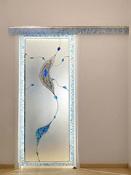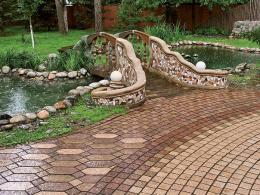Search
Login
DIY garden paths at a low cost
The perception of the architectural style of a personal plot primarily depends on how competently and successfully thought out the layout of the tracks and the materials from which they are made. This factor is weighty and significant, therefore it applies to both automobile paths and pedestrian ones. The paths for entering and entering the site can be located near or far from each other, due to the location of residential buildings, a garage, a carport for parking. Garden paths are intended not only for movement between frequently visited and favorite places of the site. They carry an important, aesthetic and artistic burden. The design of the paths should be thought out in such a way that it was possible to move along them under any weather conditions, they should not require special care, and their design under any conditions should remain at their best.
Content:
- Garden paths and their types
- Paths made of natural stone
- Gravel and gravel for track construction
- Rubber Tile - Great Material for More Expensiveto video
- Plastic - we use modern materials for garden paths
- Using wood to build garden paths video
- Paving slabs for paths
- Curb stone for garden paths, types video
Types of Garden Paths
The shapes of the tracks, styling patterns, the texture of the material used, the colors are quite diverse. All of the above, first of all, depends on the destination of the paths and the general architectural decoration of the garden. In addition, the material for the tracks should be practical, durable and easy to care for.

Simple types of paving inexpensive paths from simple and easily accessible materials can be performed by a person who does not have certain skills.
Carefully thought out and selected details and high-quality work performance are the guarantee of 100% of the event outcome. The household territory makes it possible to design paths of various types: from grass, gravel, brick, rubble, soil, clinker brick, tiles, monolithic concrete slabs.

When choosing material, they mainly take into account the purpose of the tracks, the style of the decoration of the site, and the possibility of acquiring certain materials. Paths from soil, grass, partly from gravel and gravel, require constant care for them.

Paths made of a denser, monolithic coating often have a more neat appearance and a longer operational period, they are more attractive and do not require special care.
Stone path
Paths made of natural stone (whether tiled or chipped) have a more expressive appearance, are famous for their long life, they pass moisture well, they are always clean and dry.

The cost of the source material is quite high. Therefore, basically, stone paths are equipped when approaching the main housing on the site. The narrow paths going to places intended for relaxation or in the immediate vicinity with flower plantations will look interesting.

The dimensions of the tiles are determined by the type of source material and the processing option. In a household territory, it is more rational to use chipped stone slabs with an irregular shape. Differences in blanks in size and shape are allowed, but the condition of the same thickness is not recommended to be violated. Otherwise, the installation process can be significantly more complicated.

Chipped-stone slabs have a lower cost than solid, differing in regular shape Also, various color variations are considered pluses. This fact makes it possible to select a material suitable for the color of stairs, walls or other architectural elements.
If desired or necessary, rubble stones can be split and given the necessary shape. To do this, you need to have a chisel and a hammer on hand.
Laying stone slabs can occur in several ways. You can lay on a layer (8 - 10 cm) of well-compacted sand. Seams in a similar masonry are also filled with sand.
Another option involves laying the slabs in a solution, which is prepared as follows: sand and cement are mixed in proportions of 1: 5. Here, the filling of the joints occurs with the prepared solution.

From improvised tools you will need a profile trowel.
Laying of individual large stones or slabs takes place directly in the ground. The base is not prepared in advance. With the help of a shovel bayonet, at the place where the laying of the plate is planned, its contour is circled.
Sod is removed in a circled place. The thickness of the removed soil should be slightly larger than the thickness of the plate itself. The deepening of the base is leveled with a thin layer of sand. Now you can lay the stone.

Ultimately, the stacked material should be slightly below ground level. This will greatly facilitate mowing nearby growing grass.
Filling the seams with a solution, you need to smooth them as evenly as possible. Carelessly made seams will spoil the visual perception of the surface.
If desired, a special dye can be added to the grout.

Contrast color will give a colorful effect. An unusual and interesting look to stone paths gives not only the naturalness of the material, but also the pattern, which is obtained by combining plates of different shapes and dimensions.
Gravel, crushed stone for paths
Quite often, paths made of gravel or gravel are set up in an area where there is a quarry or enterprise nearby whose specificity is crushing gravel. Making tracks from such materials is not a difficult job, the service life is quite long.

Paving of tracks of these types occurs as follows:
- A bed is prepared with a depth of 15 cm, the bottom is carefully rammed.
- The first layer should consist of coarse gravel mixed with clay, its thickness should be a maximum of 11 - 12 cm.
- The layer is well filled with water and wait until it is absorbed.
- This is followed by careful rolling or tamping of the base.
- The second layer should consist of finer gravel. Its thickness should be 3-4 cm. Mandatory tamping and watering in several stages, for good shrinkage of the material.

Paths made of such natural and environmentally friendly materials will always have a natural and appropriate look, and can also be combined with a variety of architectural designs of the structures on the site.
Due to the flowability and plasticity of the material used, the track, at any time, can be modified without any special time and physical costs.

Laying gravel can be done in another way:
- A bed is prepared, large crushed stone is placed at its bottom, tamped.
- The layer should be about 5 cm.
- The next layer will consist of clay and sand. Its thickness is about 2 cm.
- It is rammed and filled with water. Shrinks are waiting.
- The next layer is made of gravel of a finer fine fraction, the thickness of the layer should be 2 cm, also fill with water.

If desired, the track can be strengthened with a curbstone. It will serve as a reinforcing element for the track, and will also prevent the spread of gravel on the sides. The placement of the curb stone, in relation to the ground level, can occur in a variety of ways.
Rubber tile for paths
This type of coating is made of rubber. Rubber tiles are obtained by processing rubber tires, using a specially developed technology. Despite the fact that secondary raw materials are used to obtain a rubber coating, the cost of the resulting material is quite high. Price is directly related to a complex process.
The material has many advantages:
- light weight, about two times lighter compared to cement blocks;
- absolutely not slippery, other coatings after rain cannot boast of this quality;
- does not retain water on its surface;
- very elastic, serves as protection against severe injuries in the fall, very suitable for covering playgrounds intended for children;
- has a long operational period (about 10 years), thanks to special manufacturing technologies, it does not deform when temperature changes;
- produced in two types: waterproof and waterproof;
- it does not collapse and does not deform during transportation, it is very convenient when ordering from a manufacturer located at a great distance from its destination, the customer can be completely sure that the material will be delivered intact.

A rubber coating of various shapes and thicknesses is produced. Based on the fact that rubber is a material that paints well, rubber tiles of any of the desired colors can be purchased if desired.

Such a variety will help create almost any conceived picture on the site.
We look how to lay a track from a rubber tile:
Plastic for garden paths
This type of material is not expensive and quite practical to use, well tolerates the load during operation. Its laying and installation provide familiarization with certain technologies of this process.

Plastic products can imitate almost all textures:
- metal,
- marble,
- tile,
- ceramics,
- a rock.
That is why, products of this kind are popular in the design of various finishes. Choosing material for the design of the garden path, it is worth stopping your choice on plastic.
The recommendation can be substantiated with the following advantages:
- practicality and ease of care for the material during operation;
- high degree of resistance to moisture, changes in ambient temperature, mechanical damage;
- wide color palette;
- corrugated coating of plastic tiles prevents sliding on it, which in turn prevents injuries;
- lower cost compared to ceramics and natural stone.

The composition of the finishing plastic tile, in addition to plastic, includes: polymer and other additives. They help to create the desired texture of the material, color, resistance to various natural factors. In European countries, it has long become very popular.

Its installation is carried out in this way:
- it is necessary to remove the upper part of the turf, about a quarter meter;
- level the base with sand and compact well;
- lay tile polystyrene foam, such a heater is not exposed to moisture and frost;
- prepare a sand-cement mortar and perform styling;
- fill each seam with sand.

Experts advise: on hot summer days, to avoid the appearance of an unpleasant smell from the tile, from time to time to water it.
Using wood for garden paths
The wood cover on the walkways will look especially successful if the apartment building is designed as a log cabin. This coverage option is the most budgetary.

Its arrangement does not take much time and does not require certain skills. It is worth paying attention to the fact that the operational period of such tracks will not be long. A tree under the influence of natural factors pretty quickly become worthless.
Those who decide to arrange wooden paths on the site should pay attention to the hardwood material.

There are two main types of wood track lining:
- wooden beam;
- wood cuts.
In regions with a dry climate, it is permissible to use a thick board or timber. Their purchase can be made at any hardware store. Wooden fragments should be all the same and have a length of 100 cm, a width of 30 cm, a thickness of 20 cm. They are laid in a prepared base, on the bottom of which sand or gravel is placed.

Each wood fragment should be treated with an antiseptic solution or, in extreme cases, fuel oil. The composition will serve as protection against decay and deformation in contact with water.
Outdated country trees are suitable for the design of the track with the help of saw cuts. You can use both the stem part and the branches (they fill the voids between the thick cuts of the trunk). Saws are pre-treated with heated drying oil. The procedure is best done several times. So the tree will serve much longer.

Laying takes place on the same principle as with boards: a base is prepared equal to the length of the saw, polyethylene or geotextile is placed on the bottom, then the saw cuts are installed. The voids formed between the saw cuts and parts of the branches are filled with sand or small gravel.
Examples of beautiful wooden walkways:
Paving slabs for paths
When choosing paving slabs for a garden path, attention should be paid not only to its cost, but also to the manufacturing technology and the manufacturer.

Parameters for selection should be:
- visual perception
- quality,
- dimensions of fragments.
When choosing a colored tile you need to be careful. Its quality can be very low due to the large amount of dye in it. Quality is checked by hitting the tile against the tile. If the sound is voiced - the tile is good, if deaf - the tile has flaws and it is better to refuse to buy it.

Having decided on the material, it is necessary to make calculations and determine how much is needed. 5% is usually added to the resulting figure, which will block the battle, various deformations, and so on.

The most common form is concrete tile. The material is very durable and environmentally friendly.
Curb stone for garden paths, types
The border is not the main fragment of the track, but important. Its presence can significantly improve the visual perception of both the path and the entire site.

Its design can be made with different materials. The simplest one is made of brick, which is installed by the end face and slightly immersed in the ground. For greater reliability, the joints between the bricks can be strengthened with cement mortar.

The original framing of the path can be achieved with the help of wooden chocks. Whether it will be installed at the same height or at different, it is up to the owner to decide.

A natural stone will look beautiful and rich as a border. They can be of different colors, and of different dimensions. Here you can let go of your imagination. The main thing is that the result is pleasing to the eye.
A variety of modern materials gives a lot of opportunities and options for performing framing tracks, that is, borders.

The main task is to make the frame so that it is combined with the material from which the track is made, and with the general perception of the architectural style of the infield.
Watch a video about installing the curb with your own hands:





